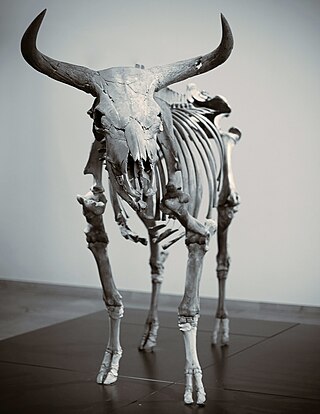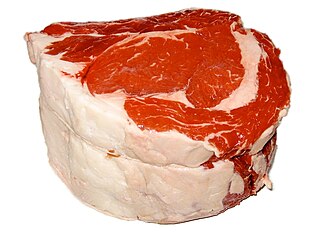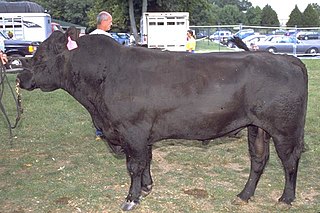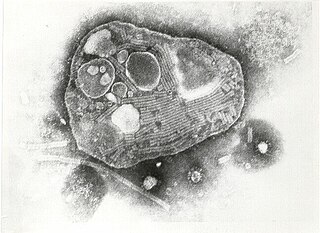
The aurochs is an extinct cattle species, considered to be the wild ancestor of modern domestic cattle. With a shoulder height of up to 180 cm (71 in) in bulls and 155 cm (61 in) in cows, it was one of the largest herbivores in the Holocene; it had massive elongated and broad horns that reached 80 cm (31 in) in length.

Beef is the culinary name for meat from cattle.

The zebu, sometimes known in the plural as indicine cattle or humped cattle, is a species or subspecies of domestic cattle originating in the Indian sub-continent. Zebu are characterised by a fatty hump on their shoulders, a large dewlap, and sometimes drooping ears. They are well adapted to withstanding high temperatures, and are farmed throughout the tropical countries, both as pure zebu and as hybrids with taurine cattle, the other main type of domestic cattle. Zebu are used as draught and riding animals, dairy cattle, and beef cattle, as well as for byproducts such as hides and dung for fuel and manure. Some small breeds such as the miniature zebu are also kept as pets. In 1999, researchers at Texas A&M University successfully cloned a zebu.

A cowboy is an animal herder who tends cattle on ranches in North America, traditionally on horseback, and often performs a multitude of other ranch-related tasks. The historic American cowboy of the late 19th century arose from the vaquero traditions of northern Mexico and became a figure of special significance and legend. A subtype, called a wrangler, specifically tends the horses used to work cattle. In addition to ranch work, some cowboys work for or participate in rodeos. Cowgirls, first defined as such in the late 19th century, had a less-well documented historical role, but in the modern world work at identical tasks and have obtained considerable respect for their achievements. Cattle handlers in many other parts of the world, particularly South America and Australia, perform work similar to the cowboy.

The Jersey is a British breed of small dairy cattle from Jersey, in the British Channel Islands. It is one of three Channel Island cattle breeds, the others being the Alderney – now extinct – and the Guernsey. It is highly productive – cows may give over 10 times their own weight in milk per lactation; the milk is high in butterfat and has a characteristic yellowish tinge.

The domestic yak, also known as the Tartary ox, grunting ox or hairy cattle, is a species of long-haired domesticated cattle found throughout the Himalayan region of the Indian subcontinent, the Tibetan Plateau, Kachin State, Yunnan, Sichuan, Gilgit-Baltistan (Kashmir), and as far north as Mongolia and Siberia. It is descended from the wild yak.

The Aberdeen Angus, sometimes simply Angus, is a Scottish breed of small beef cattle. It derives from cattle native to the counties of Aberdeen, Banff, Kincardine and Angus in north-eastern Scotland. In 2018 the breed accounted for over 17% of the UK beef industry.

The cattle egret is a cosmopolitan species of heron found in the tropics, subtropics, and warm-temperate zones. It is the only member of the monotypic genus Bubulcus, although some authorities regard its two subspecies as full species, the western cattle egret and the eastern cattle egret. Despite the similarities in plumage to the egrets of the genus Egretta, it is more closely related to the herons of Ardea. Originally native to parts of Asia, Africa, and Europe, it has undergone a rapid expansion in its distribution and successfully colonised much of the rest of the world in the last century.

The Hereford is a British breed of beef cattle originally from Herefordshire in the West Midlands of England. It has spread to many countries – there are more than five million purebred Hereford cattle in over fifty nations worldwide. The breed was first exported from Britain in 1817, initially to Kentucky. It spread across the United States and Canada, through Mexico, to the great beef-raising countries of South America. Today Herefords dominate from Australasia to the Russian steppes, including Israel, Japan, continental Europe and Scandinavia, temperate parts of Australia, Canada, the United States, Kazakhstan and Russia, the centre and east of Argentina, Uruguay, Chile, and New Zealand, where they make up the largest proportion of registered cattle. They are found all over Brazil and in some Southern African countries, notably South Africa, Zambia and Zimbabwe.

The Australian Cattle Dog (ACD), or simply Cattle Dog, is a breed of herding dog originally developed in Australia for droving cattle over long distances across rough terrain. This breed is a medium-sized, short-coated dog that occurs in two main colour forms. It has either red or black hair distributed fairly evenly through a white coat, which gives the appearance of a "red" or "blue" dog.

Rinderpest was an infectious viral disease of cattle, domestic buffalo, and many other species of even-toed ungulates, including gaurs, buffaloes, large antelope, deer, giraffes, wildebeests, and warthogs. The disease was characterized by fever, oral erosions, diarrhea, lymphoid necrosis, and high mortality. Death rates during outbreaks were usually extremely high, approaching 100% in immunologically naïve populations. Rinderpest was mainly transmitted by direct contact and by drinking contaminated water, although it could also be transmitted by air. After a global eradication campaign starting in the mid-20th century, the last confirmed case of rinderpest was diagnosed in 2001.

Kobe beef is Wagyu beef from the Tajima strain of Japanese Black cattle, raised in Japan's Hyōgo Prefecture according to rules set out by the Kobe Beef Marketing and Distribution Promotion Association. The meat is a delicacy, valued for its flavor, tenderness, and fatty, well-marbled texture. Kobe beef can be prepared as steak, sukiyaki, shabu-shabu, sashimi, and teppanyaki. Kobe beef is generally considered one of the three top brands, along with Matsusaka beef and Ōmi beef or Yonezawa beef.

Dairy cattle are cattle bred for the ability to produce large quantities of milk, from which dairy products are made. Dairy cattle generally are of the species Bos taurus.

The Bali cattle, also known as Balinese cattle, domestic banteng or Bali banteng, are a domesticated species of bovine which originated from the banteng. Bali cattle are an important source of meat and are used for plowing. They are thought to have originated in Bali.

Bovine spongiform encephalopathy (BSE), is an incurable and invariably fatal neurodegenerative disease of cattle. Symptoms include abnormal behavior, trouble walking, and weight loss. Later in the course of the disease the cow becomes unable to function normally. There is conflicting information around the time between infection and onset of symptoms. In 2002, the WHO suggested it to be approximately four to five years. Time from onset of symptoms to death is generally weeks to months. Spread to humans is believed to result in variant Creutzfeldt–Jakob disease (vCJD). As of 2018, a total of 231 cases of vCJD had been reported globally.

Cattle are large, domesticated, cloven-hooved, herbivores. They are a prominent modern member of the subfamily Bovinae and the most widespread species of the genus Bos. Adult females are referred to as cows and adult males are referred to as bulls.

Kerala Solvent Extractions Ltd, now known as KSE Ltd, is a company that is engaged in the manufacture of cattle feed, oil cake processing, and dairy products in Irinjalakkuda, Thrissur District, state of Kerala, India. The Company was incorporated on 25 September 1963 and began commercial operations in April 1972 by setting up Kerala's first solvent extraction plant to extract coconut oil from coconut oil cakes. Subsequently, in 1976 the company set up a plant to manufacture ready mixed cattle feed. In the last three decades, KSE has emerged as a leader in solvent extraction from coconut oil cakes and also the largest cattle feed producer and supplier in Kerala. In 2000, KSE entered the business of procuring, processing and marketing milk and milk products. In 2002, KSE started producing and marketing icecreams under the brand name 'Vesta'.

A bull is an intact adult male of the species Bos taurus (cattle). More muscular and aggressive than the females of the same species, bulls have long been an important symbol in many religions, including for sacrifices. These animals play a significant role in beef ranching, dairy farming, and a variety of sporting and cultural activities, including bullfighting and bull riding and also used for ploughing of land

Cattle slaughter in India, especially cow slaughter, is controversial because of cattle's status as endeared and respected living beings to adherents of Hinduism, Sikhism, Jainism, Buddhism; while being an acceptable source of meat for Muslims, Christians and Jews. Cow slaughter has been shunned for a number of reasons, specifically because of the cow's association with the god Krishna in Hinduism, and because cattle have been an integral part of rural livelihoods as an economic necessity. Cattle slaughter has also been opposed by various Indian religions because of the ethical principle of Ahimsa (non-violence) and the belief in the unity of all life. Legislation against cattle slaughter is in place throughout most states and territories of India.


















